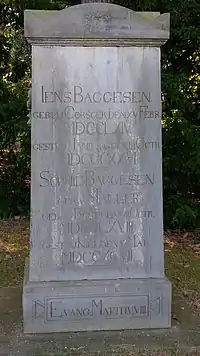Jens Baggesen | |
|---|---|
 Jens Baggesen, pastel by Christian Horneman made during a visit to Copenhagen in 1806 from Paris where Baggesen lived at the time | |
| Born | Jens Immanuel Baggesen 15 February 1764 Korsør, Denmark |
| Died | 3 October 1826 (aged 62) Hamburg, German Confederation |
| Occupation | Poet |
| Nationality | Danish |
| Literary movement | Romanticism |
| Notable works | Labyrinten "Da Jeg Var Lille" |
| Signature | |
 | |
Jens Immanuel Baggesen[1] (15 February 1764 – 3 October 1826) was a major Danish poet, librettist, critic, and comic writer.
Life

Baggesen was born at Korsør on the Danish island of Zealand on February 15, 1764.[2] His parents were very poor, and he was sent to copy documents at the office of the clerk of Hornsherred District before he was twelve. He was a melancholy, feeble child, and he attempted suicide more than once. By dint of indomitable perseverance, he managed to gain an education; in 1782, he entered the University of Copenhagen.[2]
His first work—a verse Comical Tales broadly similar to the later Broad Grins of Colman the Younger—took the capital by storm and the struggling poet found himself a popular favorite at age 21.[2] He then tried more serious lyric poetry and his tact, elegant manners, and versatility gained him a place in the best society.[2] In March 1789, his success collapsed when his opera Holger Danske was received with mockery of its many faults[2] and a heated nationalist controversy over Baggesen's association with Germans. He left Denmark in a rage and spent the next years in Germany, France, and Switzerland.[2]
In 1790, he married at Bern and began to write in German.[2] He published his next poem Alpenlied ("Alpine Song") in that language, but brought the Danish Labyrinten ("Labyrinth") as a peace offering upon his return to Denmark in the winter. It was received with unbounded homage.[2] Over the next twenty years, he published volumes alternately in Danish and German and wandered across northern Europe before settling principally in Paris.[2] His most important German work during this period was the 1803 idyllic hexameter epic called Parthenais.[2]
Upon his 1806 visit to Copenhagen, he found the young Oehlenschläger hailed as the great poet of the day and his own popularity on the wane.[2] He then stayed, engaging in one abusive literary feud after another, most with the underlying issue that Baggesen was determined not to allow Oehlenschläger to be considered a greater poet than himself.[2] He finally left for Paris in 1820, where he lost his second wife and youngest child in 1822.[2] Suffering a period of imprisonment for his debts, he fell at last into a hopeless melancholy madness.[2] Having slightly recovered, he determined to see Denmark once more, but died en route at the Freemasons' hospital in Hamburg on October 3, 1826.[2] He was buried at Kiel.[2]
Legacy
Baggesen's many-sided talents achieved success in all forms of writing, but his political, philosophical, and critical works fell out of favor by the mid-19th century.[2] His satire is marred by his egotism and passions, but his comic poems are deathless.[2] His finished and elegant style was very influential on later Danish literature, in which he is regarded as the major figure between Holberg and Oehlenschläger.[2] His greatest success, however, has proven to be the simple song Da Jeg Var Lille[3] ("There Was a Time when I Was Very Little")[4] which was known by heart among Danes a century after his death[2] and still remains popular. It has outlived all of his epics.
There is a statue of Baggesen on Havnepladsen in Korsør, unveiled on 6 May 1906 by Professor Vilhelm Andersen. The local Best Western hotel is also named after him.
References
- ↑ Also formerly written as Jens Emmanuel Baggesen.(Gosse 1911, p. 200)
- 1 2 3 4 5 6 7 8 9 10 11 12 13 14 15 16 17 18 19 20 One or more of the preceding sentences incorporates text from a publication now in the public domain: Gosse, Edmund William (1911). "Baggesen, Jens Immanuel". In Chisholm, Hugh (ed.). Encyclopædia Britannica. Vol. 3 (11th ed.). Cambridge University Press. p. 200.
- ↑ Baggesen, Jens (1801), "Da jeg var lille", Samtlige Værker, Vol. I (in Danish), archived from the original on 2016-03-04
- ↑ "There Was a Time when I Was Very Little", Library of the World's Best Literature
External links
- Gosse, Edmund William (1878). . In Baynes, T. S. (ed.). Encyclopædia Britannica. Vol. 3 (9th ed.). New York: Charles Scribner's Sons. pp. 230–231.
- Works by or about Jens Baggesen at Internet Archive
- Works by Jens Baggesen at LibriVox (public domain audiobooks)

